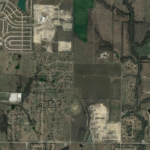The Wall Street Journal recently asked me to identify and rank the nation’s toughest places to build housing. This blog post provides readers with the full set of rankings, as well as commentary and a rundown of the data and methods used.

Download Rankings
- Metropolitan areas
- Zip code areas, ranked nationally
- Zip code areas, ranked within metropolitan areas
How to identify tough-to-build places?
One might think that places which are slower to permit construction or reject a greater share of plans are tougher to build in than others, but the opposite is often true. The toughest places to build tend to see few, if any, proposals for new construction because developers know to conserve their energy by pursuing more feasible alternatives. For example, if expensive Silicon Valley suburbs like Palo Alto were to sprout glass condo towers in the midst of single-family homes, they would sell out in no time. However, the fact that no developer wastes their time proposing such a project doesn’t mean it would be easy for a developer to swoop in to build it. On the contrary.
A better way to gauge the toughest places to build is to ask “where does an increasing willingness to pay for housing fail to result in more housing being built?” If people are willing to pay increasing amounts of money for housing, then a paucity of new homes indicates that construction is obstructed, i.e. that it is a “tough-to-build” area. The obstruction can stem from natural geography, from man-made constraints on what may be built, or – as is generally the case – from a mixture of both. Therefore, stunted or delayed construction plans do not indicate that a place is tough-to-build. In fact, it often indicates that plans are likely enough to succeed that they’re worth a shot for developers.
An exception to the rule is the rust-belt scenario in which existing homes – left over from better economic times – are sufficiently abundant relative to current needs to keep the price of housing below the cost of new construction. In this case, there is little impetus to build.
Metropolitan Areas
The extent to which American metro areas are tough-to-build is closely related to their ability and tendency to expand their developed footprint and to densify within that footprint.
Below is the metro area chart, published by the Wall Street Journal. Data-visualization master Edward Tufte would surely argue that their chart is more effective than my original chart at delivering the information visually (it is even entitled “When Less is More”). Aside from squaring the rectangle, switching the axes and clearing the visual clutter, there are three noteworthy differences between The Wall Street Journal’s chart and my original version, beneath it:
First, The Wall Street Journal omitted plotted metro areas that were not labeled in the original; they can be found in the rankings available for download, above.
Second, The Wall Street Journal also omitted metro areas in which the impetus to build was weak, which appear with triangular markers in the original chart (I have referred to these cities elsewhere as legacy cities). Whereas Detroit and Cleveland have seen declining home prices and little new construction, Pittsburgh and Buffalo have experienced price increases, but these price gains are not yet sufficient to trigger significant amounts of new construction. New Orleans is more complicated because of Hurricane Katrina.
Finally, the original chart emphasizes that it is each metro area’s direction with respect to the origin that represents how tough it is to build. Thus:
- It is tougher to build in Honolulu and Los Angeles than in San Francisco and New York.
- New York and Philadelphia are tougher-to-build than Boston and Miami, which are tougher than Washington, which is tougher than Seattle.
- Seattle and Riverside – whose metro area spans Los Angeles’ so-called “Inland Empire” – are roughly on par with each other.
- Denver and Houston are roughly on par with each other as well but are both tougher to build than Dallas, Phoenix, and Austin.
- Except for Las Vegas, the large metros in which it is easiest to build are located in the Southeast, and Atlanta stands out as the easiest among them.
Zip Code Areas
The best arbiters of the zip code area rankings are the long time residents of each metro, who know the places from personal experience. Nevertheless, a handful of broad observations are in order:
- The toughest places to build are not downtown. It is expected and accepted that U.S. downtowns be dense, and once density is accepted in an area it is easy to build more there.
- The toughest-to-build places tend to be in the inner suburbs. Local land use rules typically codify as taboo dense construction outside of downtowns and in the vicinity of transit hubs. Because the inner suburbs have been around longer than more distant suburbs, the inner suburbs are more likely to have depleted their supply of vacant lots, leaving no room for “acceptable” new construction. The three toughest-to-build neighborhoods featured in The Wall Street Journal – Venice Beach in Southern California (90291), Prospect-Lefferts Gardens in Brooklyn (11225) and the Fishtown section of Philadelphia (19125) – all fall into this category.
- The toughest-to-build places are often in gentrifying neighborhoods. While the process of gentrification is in progress, neighborhoods experience sharp housing price appreciation. However, because gentrification is often closely tied to the neighborhood’s physical charm, housing price appreciation is rarely met by equally large increases in the rate of new construction. As a result, gentrifying neighborhoods often elicit an increasing willingness to pay for housing while failing to get more housing built, i.e. they are tough-to-build. The three toughest-to-build neighborhoods featured in The Wall Street Journal fall into the gentrifying neighborhood category as well.
- Another variety of tough-to-build places consists of exclusive and wealthy low-density enclaves. When such enclaves are sufficiently mature that they no longer harbor vacant land eligible for construction, they often fail to produce any new housing. In metro areas that continue to sprawl, gentrification is less common and the sharpest housing price appreciation often occurs in exclusive, wealthy enclaves such as these. The Villages in Houston (77024) and Brookhaven in Atlanta (30319) are good examples.



Leave a Reply